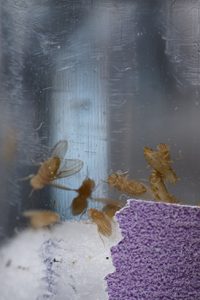From the October 2016 Desktop News | For a fruit fly, what its grandparents ate may affect how much it weighs. And, according to Dr. Laura Reed, an assistant professor in the Department of Biological Sciences, similar relationships between generational diet and obesity may hold true for humans as well.

To study obesity, Reed and her team experiment with the diets of fruit flies. They feed some of the larvae a high-fat diet while they give the control group a regular diet. Then, the researchers study weights and phenotypes—physical characteristics, such as fat storage—of subsequent generations of fruit flies fed on a regular diet. Flies with the high-fat grandparents may have the obese phenotype, depending on which grandparent—grandma or grandpa—got the special diet.
The paper containing their results, “Genetic and sex-specific transgenerational effects of a high fat diet in Drosophila Melanogaster,” was published Aug. 12 in the journal PLOS ONE.
“For flies—as has also been shown in humans and other systems—what their grandparents eat affects the descendants’ body weight,” Reed said. “Two genetically identical flies that are raised on the same diet could have predictably different weights if one fly’s grandfather ate a high-fat diet verses if the other fly’s grandmother ate a high-fat diet.”
Reed’s coauthors are Kelly Dew-Budd of the School of Plant Sciences at the University of Arizona and Julie Jarnigan, research technician in the Department of Biological Sciences at UA. The study examines the genotype—genetic makeup—and traits of 10 genetic lines of three generations of flies. They arrived at three primary conclusions:
—There are important differences between the way genotypes and genders are affected by their ancestors’ high-fat diets.
— The sex of the ancestor exposed to the high-fat diet influences how and if subsequent generations are affected.
—Just because the grandparent received a high-fat diet did not necessarily mean that all descendants will show characteristics of obesity.

“The implication of these results is that, given our interest in understanding and preventing metabolic diseases like obesity, we need to consider the contribution of ancestral environmental experiences,” Reed said. “However, we need to be cautious when drawing population-level generalization from small studies, because transgenerational effects are likely to exhibit substantial sex and genotype specificity.”
Reed said this research explores “epigenetics,” a current trend in popular science that explores whether inherited traits from ancestors can be determined by environmental factors.
Environment can change how genes express characteristics without changing the genetic code itself. The study implicates epigenetics, but much more study is necessary to fully understand how the effects are transmitted mechanistically.
“Imagine two identical strands of multicolored holiday lights,” Reed said. “The strands represent the DNA of two organisms while the bulbs represent individual genes. Even though the strands are the same, it is possible for the individual bulbs to be on or off in a distinct pattern between the two strands. Similarly, genes can be turned on or off, or expressed, in different patterns on two strands of DNA. The pattern of gene expression is determined by epigenetics.”
The current study shows that environment—the fatty diet—may change the phenotype of descendants, but it’s still too soon to generalize the findings to an entire population, or, for that matter, to human society. A link exists, but its strength is still debatable, given the influence of which grandparent got the high-fat diet.